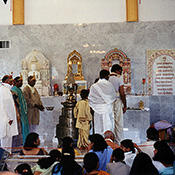 Jain monastics depend on the laypeople for food and essentials. Possessing no permanent home, Jain monastics travel on foot and teach Jain tradition and scripture to laypeople. The monastics live a life of constant travel, with the exception of monsoon season, when they spend four months in one place.
Jain monastics depend on the laypeople for food and essentials. Possessing no permanent home, Jain monastics travel on foot and teach Jain tradition and scripture to laypeople. The monastics live a life of constant travel, with the exception of monsoon season, when they spend four months in one place.
On becoming renouncers, Jain mendicants take the five vows with utmost seriousness. They have no home, cook no food, carry no money. Traditionally, these mendicants are supposed to move from village to village, teaching and studying, accepting only what food someone offers them along the way. Monks (sadhus) and nuns (sadhvis) rely heavily upon the laity, yet they become, for the laity, living images of the ideal of self-realization attained by Mahavira and the other tirthankaras. One might say that they beg for food from the laity, but Jain householders would put it the other way around: they themselves beg the mendicants to do them the honor of accepting food from their household.
As ascetics, these monks and nuns put down the roots of home nowhere, accumulating no possessions and staying only a few days in one place. Their life is traditionally one of constant movement, traveling and teaching. They walk barefoot, for travel by vehicles is seen to be much more damaging to the multitude of tiny life-forms. During the months of the monsoon season in India, however, the rivers become swollen and travel by foot becomes difficult. In addition, it is all the more dangerous for the many organisms that emerge in the rain and might be trampled on the unpaved road. For this reason, during the four months of the rainy season, Jain monastics stay in one place.
It is the monks who are the teachers of the tradition and who help Jain lay people to understand the scriptures. The monsoon season is an especially important season for teaching. Jain sadhus and Jain communities plan these four-month visitations with care. It is during this time that the Jains’ most important annual observances take place—the eight-day period of Paryushana of the Shvetambaras and the ten-day period of Das Lakshan of the Digambaras—during which the entire community focuses its energy and attention on fasting, instruction, and the rite of pratikraman, in which each person asks forgiveness for the faults of the previous year.